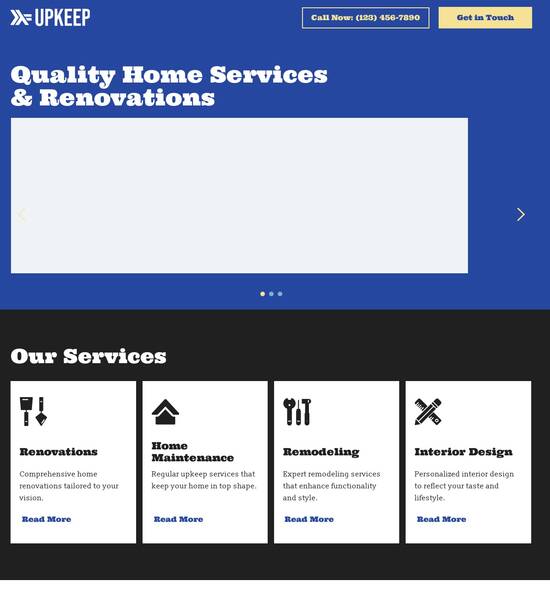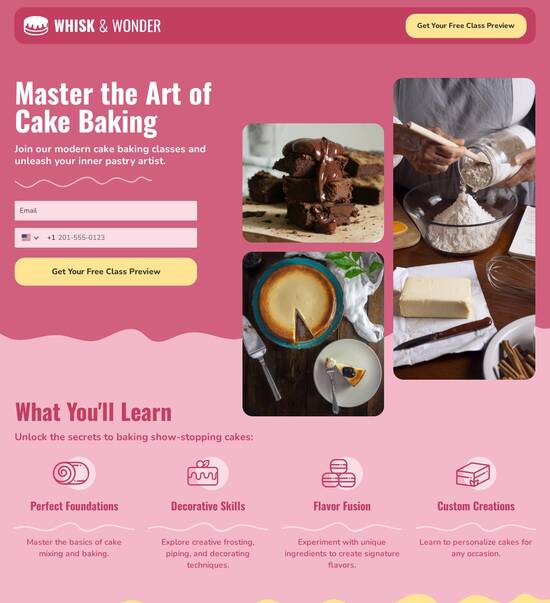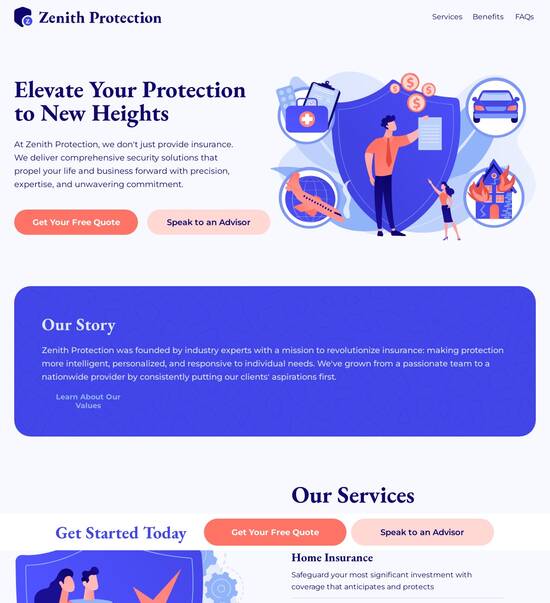
HTML page template with interactive partnership inquiry form
Explore Similar TemplatesAbout template
Use HTML page templates with interactive partnership inquiry form and make your communications easy and transparent. Try our solution today.
Recommended templates

Easy to build without coding
With the intuitive drag-and-drop builder, anyone on your team can create high-converting pages without any knowledge of code or design. Make enhancements to your landing page with custom widgets using Javascript, HTML/CSS, or third-party scripts.

Multiple layouts for any industry and goal
Select from 500+ landing page layouts built to boost conversions across industry-specific scenarios. Customize them by adjusting fonts, adding images, and generating on-brand content with the AI assistant. Quickly scale with Instablocks® and Global Blocks that you can save, reuse, and update globally.

Loads fast and looks polished on any device
Every template is responsive, which means they present professionally on any device and load blazingly fast with our Thor Render Engine. You can also power them up with Google AMP technology to deliver an unparalleled mobile experience and drive higher conversions.

Robust analytics & experimentation
Get real-time updates and reporting across all your devices, showing the number of visitors, conversions, cost-per-visitor, and cost-per-lead. Launch AI-powered experiments, run A/B tests, and use heatmaps to analyze user behavior, then optimize your landing page to maximize conversions.







Easy to build without coding
With the intuitive drag-and-drop builder, anyone on your team can create high-converting pages without any knowledge of code or design. Make enhancements to your landing page with custom widgets using Javascript, HTML/CSS, or third-party scripts.
Multiple layouts for any industry and goal
Select from 500+ landing page layouts built to boost conversions across industry-specific scenarios. Customize them by adjusting fonts, adding images, and generating on-brand content with the AI assistant. Quickly scale with Instablocks® and Global Blocks that you can save, reuse, and update globally.
Loads fast and looks polished on any device
Every template is responsive, which means they present professionally on any device and load blazingly fast with our Thor Render Engine.
Robust analytics & experimentation
Get real-time updates and reporting across all your devices, showing the number of visitors, conversions, cost-per-visitor, and cost-per-lead. Launch AI-powered experiments, run A/B tests, and use heatmaps to analyze user behavior, then optimize your landing page to maximize conversions.
All the features you need to build inquiry form templates
Explore more featuresLearn how to build website design inquiry template
Frequently asked questions about inquiry form template
Leading the way in building high-performing landing pages





Inquiry website template: Your ultimate how-to guide
Instapage offers a unique all-in-one platform for creating high-converting landing pages and enhancing conversion rate optimization (CRO). With tailored features designed to meet the specific needs of marketers across various industries, this platform is built to help businesses in the USA drive results efficiently.
Why choose Instapage for your landing page needs?
Instapage empowers marketers by providing powerful tools to accelerate and maximize ROI. By removing the complexities typically associated with landing page creation, it enables seamless campaign execution, regardless of team size or budget. Here’s why it stands out:
- 100+ ready-to-use templates: Gain immediate access to a wide variety of high-converting templates that streamline the launching process, ensuring your campaigns go live faster.
- Dynamic personalization features: Customize content delivery to your audience, using techniques like dynamic text replacement and AdMaps for improved engagement.
- Built-in optimization tools: Analyze performance with advanced heatmaps, A/B testing capabilities, and an analytics dashboard that provides actionable insights.
Step 1: Define your objectives clearly
Understanding your campaign goals is crucial. Before creating your landing page, pinpoint what actions you want visitors to take. Here’s how you can approach this step:
- Identify target audience: Understand who your campaign is aimed at, focusing on demographics relevant to your industry (e.g., Business Services, Tech/SaaS).
- Set measurable goals: Define what success looks like. Consider metrics such as conversion rate, lead quality, and ROI.
- Draft a clear value proposition: Make sure your page succinctly conveys what differentiates your offer from competitors.
Step 2: Leverage templates and build your page
With your objectives set, it’s time to utilize Instapage's rich library of templates. Choose one that aligns with your goals and customize it to fit your brand. Here’s how to effectively utilize the available resources:
- Customize design elements: Adjust fonts, colors, and layouts to match your brand identity and appeal to your target audience.
- Incorporate lead generation tools: Include forms, CTAs, and other lead capture mechanisms to optimize your chances of conversion.
- Test variations: Use A/B testing to experiment with different designs and messaging to discover which resonates best with your audience.
Step 3: Optimize and Launch
Before going live, ensure each element on your page is optimized for conversions. Follow these guidelines to finalize your page:
- Review SEO best practices: Use relevant keywords throughout to improve search engine visibility and attract organic traffic.
- Ensure mobile-friendliness: Optimize your page design for mobile devices, given the significant volume of traffic originating from smartphones.
- Monitor performance post-launch: Utilize Instapage’s analytics tools to track your landing page’s effectiveness and make continuous improvements.
In summary, Instapage offers comprehensive solutions designed for marketers looking to enhance their online campaigns effectively.
Ready to accelerate your digital marketing efforts? Start using Instapage today to build high-converting landing pages tailored to your marketing objectives.
People also ask about inquiry template form
HTML page template with interactive partnership inquiry form
Defining the core purpose of an interactive partnership inquiry form
A partnership inquiry form serves a crucial role in streamlining communication between businesses and potential partners. It acts as a bridge that allows interested parties to express their intentions, leading to fruitful collaborations. By integrating an inquiry form, businesses not only simplify the process of gathering essential information but also create a professional first impression that can enhance trust and credibility.
User-friendly design is paramount in maximizing conversion rates. A well-structured form encourages users to complete their inquiries without frustration, leading to higher engagement. In today's fast-paced digital landscape, having an interactive inquiry form offers several advantages over traditional paper or static online forms. These interactive forms often include real-time validation, instant feedback, and visually engaging elements that appeal to users, ultimately increasing the likelihood of receiving valuable inquiries.
Encourages clear communication of partnership intentions.
Improves user experience through easy navigation.
Facilitates data collection in a structured manner.
Exploring the HTML5 contact form page template
HTML5 has revolutionized web design by offering new elements and attributes that enhance the functionality and aesthetic of web pages. This modern markup language allows for the creation of responsive forms that adapt seamlessly across devices, an essential feature in today’s mobile-oriented world. An HTML5 contact form page template combines various essential components that cater to user needs while ensuring compatibility and accessibility.
Key components of a well-structured HTML5 contact form page template include several input fields such as text fields for names, email inputs for communication, and dropdowns for specific inquiries. Additionally, validation features help maintain the integrity of submitted data, providing immediate error messages to guide users. Accessibility features like ARIA attributes ensure that forms are usable by individuals with disabilities, enhancing the reach and effectiveness of the inquiry process.
Input fields like text, email, and dropdowns enhance data collection.
Validation mechanisms help maintain form integrity and user satisfaction.
Accessibility features ensure broader inclusivity.
For instance, an HTML5 contact form could look like this: Partnership Service Submit Inquiry
Integrating Google Maps backgrounds into partnership inquiry forms
Incorporating Google Maps backgrounds into partnership inquiry forms not only improves aesthetic appeal but also provides contextual relevance, especially for businesses reliant on geographical data. A visually engaging form with a map in the background allows users to easily relate their inquiries to specific locations, making the process more intuitive. A well-integrated map can provide users with immediate context about the business's operational area.
To add a Google Maps background, follow these steps: 1. Generate an embed link for the desired location in Google Maps. 2. Set this link as the background image of your form container. 3. Customize map pins that direct users to specific addresses, making your inquiry form more interactive. 4. Optimize text color and size to ensure readability against the map background.
Visually appealing designs attract more users.
Interactive elements make inquiries intuitive.
Promotes location-specific inquiries and relevance.
However, businesses must weigh the pros and cons. For instance, in real estate, users may benefit significantly from seeing property locations directly linked to their inquiries. Conversely, too much visual complexity may distract from the primary purpose of the form, leading to lower conversion rates.
Crafting a dynamic business contact form
Creating a dynamic business contact form can greatly enhance user experience and engagement. Effective contact forms should include features such as multi-step forms, which help to break down complex inquiries into digestible parts. Progressive disclosure is another useful design strategy where only the necessary questions are presented first, minimizing user anxiety and encouraging completion.
Additionally, implementing conditional logic allows businesses to show or hide fields based on previous answers. This customization helps to gather relevant information without overwhelming users. Each tailored contact form aids businesses in understanding their leads better, which is especially beneficial for industries such as real estate or service-oriented firms that require detailed inquiries.
Multi-step forms simplify complex inquiries.
Progressive disclosure reduces user overwhelm.
Conditional logic leads to more targeted inquiries.
For example, imagine a real estate agency that uses a contact form to inquire about property listings. The first step could ask for basic contact details, followed by specific property features the user is interested in, displaying only relevant options based on the user's previous answers.
User experience: Making forms more engaging
The modern user experience demands forms that are not just functional but engaging as well. Incorporating interactive design elements into forms can significantly enhance user satisfaction. Features such as animations and transitions during field interactions can make the process feel more alive and less mechanical.
Moreover, eye-catching button designs coupled with clear calls-to-action guide users seamlessly through the process. Ensuring mobile responsiveness is essential as an increasing number of users interact with forms through mobile devices. A mobile-optimized form not only enhances user experience but also encourages participation.
Interactive elements enhance user experience and engagement.
Mobile responsiveness increases usability across devices.
Clear calls-to-action drive more conversions.
The role of templates in streamlining web design
Website templates have transformed the web design landscape by providing pre-designed structures that businesses can leverage for quick and efficient web presence establishment. Different types of templates, such as static and dynamic, cater to various needs, allowing businesses to select one best suited for their goals. Industry-specific templates, particularly in sectors like real estate, offer tailored features that enhance the relevance and efficiency of the forms.
Utilizing templates significantly reduces the design time and effort required to create visually appealing and functional pages. They maintain brand consistency across platforms, ensuring that users have a cohesive experience regardless of the page being visited. Additionally, many templates offer customizable elements, enabling businesses to modify designs according to their unique value propositions.
Templates streamline the design process.
Customizable options allow for brand-specific designs.
Industry-specific templates provide relevant functionality.
Displaying content effectively on contact forms
Effective content structure within contact forms is critical for capturing user attention and guiding responses. Businesses should prioritize critical questions, ensuring that the most essential information is accessible from the outset. Using placeholder text can enhance user understanding of what is required, reducing confusion and abandonment rates.
Establishing a visual hierarchy with varying font sizes, colors, and spacing helps users navigate and understand the form quickly. Well-designed layouts create a user-friendly environment that encourages completion. For example, forms that clearly emphasize critical questions tend to yield better inquiry completions as users know precisely what’s required of them.
Prioritize critical inquiries for better completion rates.
Use placeholder text to guide user submissions.
Implement a visual hierarchy for easy navigation.
Real-world applications: Case studies and examples
Numerous businesses have successfully integrated interactive partnership inquiry forms into their operations, leading to increased engagement and lead generation. For instance, a tech startup implemented an interactive form that utilized conditional logic, allowing users to specify their needs. As a result, they saw a 30% increase in inquiries compared to a static form.
Similarly, real estate companies benefit significantly from these forms. By using visually engaging templates complete with interactive maps, they provide potential clients with a sense of transparency and relevance that traditional forms lack. Additionally, influencer marketing campaigns have utilized inquiry forms to streamline partnership requests, highlighting the diverse applications across various industries.
Increased leads through enhanced user engagement.
Real estate examples demonstrate transparency and ease of use.
Influencer partnerships benefit from streamlined requests.
Future trends in contact forms and web design
Looking ahead, the evolution of contact forms and web design is poised to undergo significant changes influenced by emerging technologies. The integration of AI and chatbot functionalities is expected to enhance user interactions, allowing businesses to provide instant support or information while users fill out inquiry forms. Personalization will play a central role in this evolution, with user-centric design approaches ensuring that forms cater to individual needs.
Moreover, as user concerns around data security and privacy grow, the importance of secure form design will see an increase. Ensuring transparency regarding data usage and implementing robust security measures will be critical in retaining user confidence. The dynamic nature of technology and user behavior will continuously reshape how partnership inquiries are processed in the digital realm.
AI and chatbots will enhance user interactions.
Personalization will drive user-centric form designs.
Data privacy and security will become critical focus areas.
Conclusion
An effective interactive partnership inquiry form is essential for modern business engagement. Utilizing HTML page templates allows for customizability and sophistication in the design of these forms, ensuring that they meet user expectations. The ongoing innovation in web design and user experience will continue to enhance the impact and relevance of inquiry forms in various industries, making them a pivotal component in the digital communication ecosystem.
Ready to skyrocket conversions?
Supercharge your ad campaigns with high-performing landing pages
Get started














